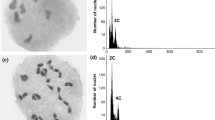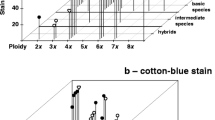Summary
The occurrence of 2n pollen-producing plants was investigated in 187 plant introductions (PIs) of 38 wild species of tuber-bearing Solanum. These 2x, 4x, and 6x species are from Mexico, and Central and South America. The determination of 2n pollen-producing plants was conducted using acetocarmine glycerol. Plants with more than 1% large-size pollen were regarded as 2n pollen-producing plants. 2n pollen-producing plants were identified in the following species: 10 out of 12 Mexican 2x species, seven of nine South American 2x species, seven of seven Mexican and Central American 4x species, five of five South American 4x species, and five of five Mexican 6x species. The frequency of 2n pollen-producing plants varied among species at the same ploidy level, but the range of frequency, generally between 2 and 10% among species, was similar over different ploidy levels. The general occurrence of 2n pollen in both 2x and polyploid species, which are evolutionarily related, is evidence that the mode of polyploidization in tuber-bearing Solanums is sexual polyploidization. Furthermore, the frequencies of 2n pollen-producing plants in autogamous disomic polyploid species were not markably different from those of their related diploid species. It is thought that the frequent occurrence of 2n gametes with autogamy tends to disturb the fertility and consequently reduce fitness of polyploids. Thus, we propose that the breeding behavior of polyploids and the occurrence of 2n gametes may be genetically balanced in order to conserve high fitness in polyploid species in tuberbearing Solanum.
Similar content being viewed by others
References
Brown CR (1988) Characterization of 2n pollen producing triploid hybrids between Solanum stoloniferum and cultivated diploid potatoes. Am Potato J 65:75–84
Camadro EL, Peloquin SJ (1980) The occurrence and frequency of 2n pollen in three diploid Solanums from northwestern Argentina. Theor Appl Genet 56:11–15
Cockerham G (1970) Genetical studies on resistance to potato viruses X and Y. Heredity 25:309–348
Dvořák J (1983) Evidence for genetic suppression of heterogenetic chromosome pairing in polyploid species of Solanum, sect. Petota. Can J Genet Cytol 25:530–539
Ehlenfeldt MK, Hanneman RE Jr (1988) Genetic control of Endosperm Balance Number (EBN): three additive loci in a threshhold-like system. Theor Appl Genet 75:825–832
Hawkes JG (1978) Biosystematics of the potato. In: Harris DM (ed) The potato crop —scientific basis for improvement. Chapman and Hall, pp 15–69
Hawkes JG(1979a) The wild tuber-bearing Solanums of North America. In: Report of the planning conference on the exploration, taxonomy and maintenance of potato germ plasm III. International Potato Center, Lima, Peru, pp 69–97
Hawkes JG (1979b) Recent concepts in the evolution of tuberbearing Solanums. In: Report of the planning conference on the exploration, taxonomy and maintenance of potato germ plasm III. International potato center. Lima, Peru, pp 126–140
Hermundstad SA (1986) Haploid wild species hybrids in potato breeding, genetics, and germ plasm enhancement. PhD thesis, University of Wisconsin-Madison, 165 pp
Huaman Z, Ross RW (1985) Updating listing of potato species names, abbreviations and taxonomic status. Am Potato J 62:629–641
Irikura Y (1976) Cytogenetic studies on the haploid plants of tuber-bearing Solanum species. II. Cytogenetical investigation on the haploid plants and the interspecific hybrids by utilizing haploids. Res Bull Hokkaido Natl Agric Exp Stn 115:1–112
Iwanaga M, Peloquin SJ (1982) Origin and evolution of cultivated tetraploid potatoes via 2n gametes. Theor Appl Genet 61:161–169
Johnston SA, Hanneman RE Jr (1980) Support for the Endosperm Balance Number hypothesis utilizing some tuberbearing Solanum species. Am Potato J 57:7–14
Johnston SA, Hanneman RE Jr (1982) Manipulation of Endosperm Balance Number overcome crossing barriers between Solanum species. Science 217:446–448
Johnston SA, Nijs TPM den, Peloquin SJ, Hanneman RE Jr (1980) The significance of genie balance to endosperm development in interspecific crosses. Theor Appl Genet 57:5–9
Lopez JLE (1979) A bio systematical study of the series Conicibaccata of the genus Solanum. PhD thesis, University of Birmingham, 185 pp
MacKey J (1970) Significance of mating systems for chromosome and gametes in polyploids. Hereditas 66:165–176
Marks GE (1955) Cytogenetic studies in tuberous Solanum species. I. Genomic differentiation in the group Demissa. J Genet 53:262–269
Marks GE (1965) Cytogenetic studies in tuberous Solanum species. III. Species relationship in some South ad Central American species. New Phytol 64:293–306
Masutani T (1962) Cytogenetic studies of the tuber-bearing Solanum species. 2. On the tetraploid species and an artificial octoploid plant in the series Longipedicellata Buk. Sci Rep Fac Agric Hokkaido Univ 41:79–82
Matsubayashi M, Misoo S (1977) Species differentiation in Solanum, Sect. Tuberarium. IX. Genomic relationships between three Mexican diploid species. Jpn J Breed 27:241–250
Mckee RK (1962) Identification of R-gene in Solanum stoloniferum. Euphytica 11:42–46
Nijs TPM den, Peloquin SJ (1977) 2n gametes in potato species and their function in sexual polyploidization. Euphytica 26:585–600
Simmonds NW (1963) Abbreviations of potato names. Eur Potato J 6:186–190
Watanabe K (1988) Occurrence, frequency, cytology, and genetics of 2n pollen; and sexual polyploidization in tuber-bearing Solanums. PhD thesis, University of Wisconsin-Madison, 267 pp
Watanabe K, Peloquin SJ (1989) Occurrence of 2n pollen and ps gene frequencies in cultivated groups and their related wild species in tuber-bearing Solanums. Theor Appl Genet 78:329–336
Author information
Authors and Affiliations
Additional information
Communicated by H. F. Linskens
Paper No. 3114 from the Laboratory of Genetics. Research supported by the College of Agriculture and Life Sciences; International Potato Center; USDA, SEA, CGRO 84-CRCR-1-1389; and Frito Lay, Inc.
Rights and permissions
About this article
Cite this article
Watanabe, K., Peloquin, S.J. The occurrence and frequency of 2n pollen in 2x, 4x, and 6x wild, tuber-bearing Solanum species from Mexico, and Central and South America. Theoret. Appl. Genetics 82, 621–626 (1991). https://doi.org/10.1007/BF00226800
Received:
Accepted:
Issue Date:
DOI: https://doi.org/10.1007/BF00226800




